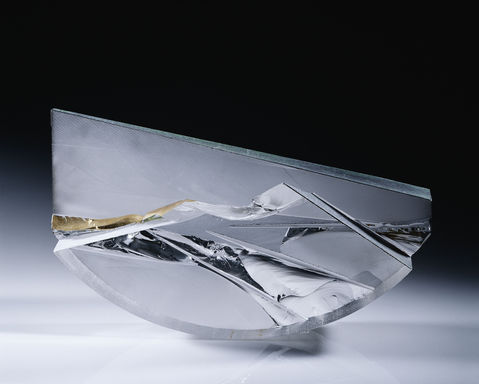
MATEI NEGREANU
Carving light through glass
"In those obscure times of the early 80s, when the art of glass in France was just beginning to be reborn, mainly in the blown form, he stood out by creating a series of pieces from sheets of industrial flat glass, due to a lack of means. While the public saw 'waves' (to the soul?), he, a calligrapher, freely drew organic, three-dimensional signs in space and forged, with strength, economy, and off the beaten path, a personal alphabet, an idiosyncratic vocabulary of elegant and sensual hyaline spirals."
Jean-Pierre Umbdenstock - 2007
"I always try to do what I don't know how to do, that's how I hope to learn how to do it."
TWO LIVES
This quote from Pablo Picasso has always inspired and guided Matei Negreanu in his life as an artist.
Negreanu has two lives. His life before 1981 in Romania contributes to his legend. Between the fading of memories and the refusal to conform to the expected discourse about Eastern countries, Matei Negreanu acknowledges that this personal history is what establishes the uniqueness of his work.
Upon arriving in France, Matei Negreanu has no idea about his future. At forty years old, he requests political asylum and has no references to show, as everything is left behind in Romania.
Nevertheless, it will take him little more than three years to establish himself on the emerging glass art scene in the early eighties.


"To leave is to be reborn, to find oneself without a single one of their works, definitively abandoned. It's an earthquake."
EXILE
Exile is first and foremost a journey, from Bucharest to Paris by train, forty hours punctuated by uncomfortable naps, military smoking breaks, and conversations with an elderly intellectual from Bucharest. After the abstinence and absence of any superfluous goods from the stores of the East, comes the abundance of the Western states. After the disorder of a country with a rich agriculture, he sees the precision of Austrian furrows.
These are images that leave a lasting impression. He will keep a taste for abundance, color, and order.
Fleeting impressions, lasting sentiments.
The first sensations of a new career. For a forty-year-old artist, leaving is to be reborn, to find oneself completely stripped of their works, definitively abandoned. It's an earthquake.

A SINGULARITY
His sculptures, a blend of wood, glass, and lead, possess an alchemy that is all the more delightful to behold as it belongs solely to him.
Harry Bellet, Le Monde, 1998
"The most important thing is the journey towards another world, towards other worlds."
TRAVEL
Take the example of the industry. A Romanian friend, Monica Damien, introduced him to the director of the glass factory in Porcieux. At forty years old, with nothing to show, it takes a lot of conviction to persuade a business leader to let you prove yourself. He will. A year later, the bankruptcy of the factory will convince Negreanu of the necessity to fight inch by inch to survive in a competitive world. Even for art, especially for art.
Journey to the theater, short. At the Théâtre de la Ville, he will be the assistant set designer for "The Lower Depths" directed by Lucian Pintillé.
Encounters, contacts, last advice from compatriots who inexorably drift away as Matei integrates into other circles.


"Anyone who works with glass is inevitably confronted with chance."
EXPLORATIONS
Another journey, around his room. After the bankruptcy of the Porcieux factory, Negreanu had nowhere to work. Glass is a bulky, fragile, delicate material. It requires voluminous and expensive tools. So, in his room, he invented the technique of glued slats.
From window glass cut into multiple identical pieces, assembled, sculpted, and finally sandblasted. This will be the beginning of a long series of wings and waves that will impose his talent and give the decisive impetus to his fame.
Clara Scremini noticed him. The gallery owner on Rue des Filles du Calvaire is the first to take an interest in this new and original work. Immediately, she offers him a solo exhibition in September 1989. A key date, that of the emergence, recognition.
Critics, specialized press. Then the work reaches the general public through articles in the national press, television reports, and the first "Discoveries" exhibition. The rest of the journey is mapped out: Amsterdam, Frankfurt, New York, Chicago, Toronto, Sapporo. The broken line, on a geographical map, of places where art lives, sells, is evaluated, and appreciated.
ARTISTIC APPROACH
With the exception of glass paste, Matei Negreanu has explored all the states of glass, the very substance of his sculpture. He subjects it to a variety of treatments: ultraviolet bonding, saw cutting, fracturing with a hammer, lead obstruction. These experiments and shaping techniques are the result of a long-standing struggle between glass and the artist. Negreanu has this dual demand of not wanting to succumb to the seductive and often deceptive qualities of glass as a material, and at the same time not wanting to deprive himself of its beauty. On this narrow line of demarcation, he charts his path with obstinacy. And if there is one thing he refuses, it is the idea that the only acceptable status for a sculptor is that of a raw material.
Matei Negreanu









